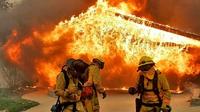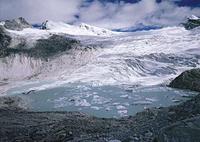-
U.S. models underestimates costs of carbon pollution
Model used by government all but ignores economic damages that climate change will inflict on future generations; two economists argue that when these costs are factored in, the real benefits of carbon reduction range from 2.6 to more than 12 times higher than the government’s estimate
-
-
Wildfires have both positive and negative economic impacts

Wildfires disrupt the lives of workers, employers, and families, and lead to longer-term instability in local labor markets, but on the flip side of the coin, countywide employment and wages increase in some sectors during the wildfires, often mitigating the short-term employment disruptions wildfires cause
-
-
Verizon’s all-hazard approach to disaster preparation
September is National Preparedness Month in the United States, but Verizon saysits Business Continuity and Emergency Management teams are busy every day of the year monitoring, preparing, and responding to weather-related and man-made events throughout the world; there are 193 member states in the UN, and the company’s BCEM teams are operating in 150 of them and in more than 2,700 cities
-
-
Regional, global food security effects of climate change to felt soon
Research shows that within the next ten years large parts of Asia can expect increased risk of more severe droughts, which will impact regional and possibly even global food security; on average, across Asia, droughts lasting longer than three months will be more than twice as severe in terms of their soil moisture deficit compared to the 1990-2005 period; China, Pakistan, and Turkey as the most seriously affected major producers of wheat and maize
-
-
Himalayan glaciers retreating at an uneven rate, making South Asia water supply future unclear

MI6, the U.K. intelligence service, four years ago predicted that the world’s first water war – that is, war between countries over access to water resources — will take place between India and Bangladesh sometime between 2015 and 2020; the reason for the war: intensifying conflicts over dwindling Himalayas water sources; glaciers in the eastern and central regions of the Himalayas appear to be retreating at accelerating rates, similar to those in other areas of the world, while glaciers in the western Himalayas are more stable and could be growing, a new report says
-
-
More accurate method for predicting hurricane activity devised
Researchers have developed a new method for forecasting seasonal hurricane activity that is 15 percent more accurate than previous techniques; the new approach should give policymakers more reliable information than current state-of-the-art methods
-
-
Hurricane Isaac tests Loyola University's emergency response plans
In the days following Hurricane Isaac’s slow march across south Louisiana, Loyola University New Orleans administrators have been reviewing their response with a critical eye to ensure emergency preparations continue to evolve and meet the demands of each situation; beginning Tuesday, 28 August, New Orleans felt the first of Isaac’s high winds and heavy rains – but Loyola University was ready
-
-
New search-and-rescue tool: remotely controlled cockroaches

Researchers have developed a technique that uses an electronic interface to remotely control, or steer, cockroaches; remotely controlling cockroaches would allow first responders to create a mobile web of smart sensors that uses cockroaches to collect and transmit information, such as finding survivors in a building that has been destroyed by an earthquake
-
-
Protecting buildings from earthquakes by hiding them

Engineers have come up with an inventive and exciting idea for protecting buildings from earthquakes: hide them (the buildings, that is); the engineers say that placing specialized rubber under the building would diverts certain temblor shock waves, leaving the building virtually untouched by them
-
-
Scientists question earthquake prediction methods
From 2008 to 2011, three earthquakes have significantly damaged different parts of the world. Those quakes were significantly underestimated by scientists and seismologists
-
-
Coastline erosion due to rise in sea level greater than previously thought

The effects of coastline erosion as a result of rising sea-level rise can be measured by acceptable engineering tools, but such an erosion in the vicinity of inlets, such as river estuaries, has until now been underestimated – and more difficult to calculate; scientists have develop a new model to calculate this more complex erosion, making a valuable contribution to coastal management, planning, and infrastructure protection
-
-
MIT expert: “toxic” political discussions limit climate response
In a talk at the Sandia National Lab, an MIT expert says the inability of natural and social scientists to convince political leaders that “we’re spinning a roulette wheel over climate change” puts humanity at “extreme risk,” and that the difficulties in using science to push for mitigation strategies are more political than scientific
-
-
In China, corruption blamed for collapse of bridges
Since 2011 eight bridges have collapsed in China, according to the state run media, including the Yangmingtan Bridge in the city of Harbin last November; the bridge was almost 10-mile long and construction was originally estimated to take three years, but workers finished it in half the time; when the bridge collapsed, the first thing on people’s mind was corruption
-
-
Earthquake hazards map contains deadly flaws

Three of the largest and deadliest earthquakes in recent history occurred where earthquake hazard maps did not predict massive quakes; scientists recently studied the reasons for the maps’ failure to forecast these quakes, and explored ways to improve the maps
-
-
Trade-offs between water for food and for curbing climate change
Earth’s growing human population needs fresh water for drinking and food production. Fresh water, however, is also needed for the growth of biomass, which acts as a sink of carbon dioxide and thus could help mitigate climate change. Does the Earth have enough freshwater resources to meet these competing demands?
-
More headlines
The long view
The Surprising Reasons Floods and Other Disasters Are Deadlier at Night
It’s not just that it’s dark and people are asleep. Urban sprawl, confirmation bias, and other factors can play a role.
Why Flash Flood Warnings Will Continue to Go Unheeded
Experts say local education and community support are key to conveying risk.
